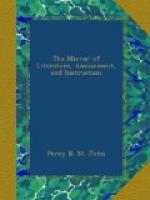THE BRAHMIN BULL, IN THE ZOOLOGICAL GARDENS, REGENT’S PARK.
[Illustration: The Brahmin bull, in the zoological gardens, regent’s park.]
The Zoological Society possess several Zebus, or Indian oxen. These were formerly considered a distinct species, but zoologists are now of opinion that the Zebu is merely a variety of the common ox, “although,” as Mr. Bennett observes, “it is difficult to ascertain the causes by which the distinctive characters of the two races have been in the process of time gradually produced."[1] Their anatomical structure is precisely the same, and the only circumstances in which the two animals differ consist in the fatty hump on the shoulders of the Zebu, and in the somewhat more slender and delicate make of its legs.
[1] Gardens and Menageries
of the Zoological Society Delineated
Quadrupeds—vol.
i.
The object of the Zoological Society in their collection of Zebus is the introduction of an improved breed of oxen. The larger specimens are kept at the farm at Kingston Hill, and only a pair of small ones are reserved for the Gardens, in addition to the Brahmin Bull, who occupies the central division of the Cattle Shed.
[Illustration: Brahmin Bull in Cattle Shed.]
The specimen before us has been received by the Society from India, and is one of the largest that has ever been seen in Europe. It is equal in size to the larger breeds of our native oxen, and is of a slaty grey on the body and head; with cream-coloured legs and dewlap, the latter exceedingly long and pendulous; very short horns directed upwards and outwards; and ears of great proportional magnitude, and so flexible and obedient to the animal’s will as to be moved in all directions with the greatest facility. Although a full-grown male, he is perfectly quiet, good-tempered, and submissive, and receives the caresses of strangers with apparent satisfaction.
The whole of the breeds of Zebus are treated with great veneration by the Hindoos, who hold it sinful to deprive them of life under any pretext whatever. They are in general used as beasts of draft, principally for purposes of husbandry, but a select number (of which the specimen before us is one,) are exempted from all services, and even idolized.
Bishop Heber,[2] calls them Brahminy Bulls, and tells us they are turned out when calves, on different solemn occasions by wealthy Hindoos, as an acceptable offering to Siva. It would be a mortal sin to strike or injure them. They feed where they choose, and devout persons take great delight in pampering them. They are exceeding pests in the villages near Calcutta, breaking into gardens, thrusting their noses into the stalls of fruiterers and pastry-cook’s shops, and helping themselves without ceremony. Like other petted animals, they are sometimes mischievous, and are said to resent with a push of their horns any delay in gratifying their wishes.




